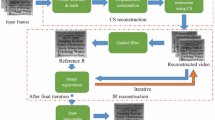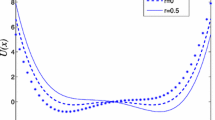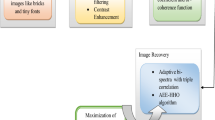Abstract
Reconstruction of an underwater object from a sequence of images distorted by moving water waves is a challenging task. Most of the environmental research has been employing image data in recent days. The precision of this research is often dependent on the superiority of image data. In the existing approaches, the problem of analyzing video sequences when the water surface is disturbed by waves. The water waves will affect the appearance of the individual video frames such that no single frame is completely free of geometric distortion. Thus, the image acquisition from the environmental condition is more complex and crucial, but it must be focused on getting the high spectral and spatial quality. The primary intent of this paper is to plan for the intelligent higher-order spectral analysis for recovering the images from the moving water surface. The three main phases of the proposed image recovery model are (a) image pre-processing, (b) lucky region selection, and (c) image recovery. Once the pre-processing of the image is carried out, the lucky region selection is performed by computing the dice coefficient method. As a modification to the existing methods, the proposed model adopts optimized bispectra to enhance the quality of the recovered image. A hybrid algorithm with Dragonfly-Colliding Body Optimization (D-CBO) is used for enhancing the bispectra method. The proposed model has been tested on distorted underwater images. From the experimental analysis, in terms of PSNR measure, the suggested D-CBO-bispectra gets better efficiency than other conventional models, in which D-CBO-bispectra is 10.7%, 8.7%, 19%, 6.8% and 5% progressed than Blind deconv, Bispectra, Bispectra with Fourier, and Radon transform, respectively. Finally, the comparison of the proposed model with the existing approaches proves the method's efficiency.












Similar content being viewed by others
Change history
20 July 2022
A Correction to this paper has been published: https://doi.org/10.1007/s11220-022-00393-3
References
Wen, Z., Lambert, A., Fraser, D., & Li, H. (2010). Bispectral analysis and recovery of images distorted by a moving water surface". Applied Optics, 49(33), 6376.
Rivenson, Y., Zhang, Y., Günaydın, H., Teng, Da., & Ozcan, A. (2017). Phase recovery and holographic image reconstruction using deep learning in neural networks. Light Science and Applications, 7, 1714.
Milder, D. M., Carter, P. W., Flacco, N. L., Hubbard, B. E., Jones, N. M., Panici, K. R., Platt, B. D., Potter, R. E., Tong, K. W., & Twisselmann, D. J. (2007). Reconstruction of through-surface underwater imagery. Waves in Random and Complex Media, 16(4), 521–530.
U. Rajendra Acharya E.Y.K. Ng S. Vinitha Sree Chua Kuang Chua Subhagata Chattopadhyay,. (2012). Higher order spectra analysis of breast thermograms for the automated identification of breast cancer. Expert Systems, 31(1), 37–47.
Tao, C., Zhu, H., Sun, P., Rengmao, Wu., & Zheng, Z. (2020). Hyperspectral image recovery based on fusion of coded aperture snapshot spectral imaging and RGB images by guided filtering. Optics Communications, 458, 124.
Yuanjin, Xu., & Wei, M. (2021). Multi-view clustering toward aerial images by combining spectral analysis and local refinement. Future Generation Computer Systems, 117, 138–144.
Siok, K., Jenerowicz, A., & Ewiak, I. (2020). A simulation approach to the spectral quality of multispectral images enhancement". Computers and Electronics in Agriculture, 174, 105.
Sandip Banerjee, and Palanisamy Shanmugam (2020) Novel method for reconstruction of hyperspectral resolution images from multispectral data for complex coastal and inland waters", Advances in Space Research, Available online
Hinich, M., & Wolinsky, M. (2005). Normalizing bispectra. Journal of Statistical Planning and Inference, 130, 405–411.
de Wit, T. D. (2003). Spectral and statistical analysis of plasma turbulence: Beyond linear techniques. Springer.
Matson, C. (1991). Weighted-least-squares phase reconstruction from the bispectrum. Journal of the Optical Society of America A, 8, 1905–1913.
Chua, K. C., Chandran, V., & U.R. Acharya And C.M. Lim,. (2009). Analysis of epileptic EEG signals using higher order spectra. Journal of Medical Engineering and Technology, 33, 42–50.
Acharya, U. R., Chua, E. P. C., Chua, K. C., & C.M. Lim And T. Tamura,. (2010). Analysis and automatic identification of sleep stages using higher order spectra". International Journal of Neural Systems, 20, 509–521.
Chua, K. C., Chandran, V., & U.R. Acharya And C.M. Lim,. (2008). Cardiac state diagnosis using higher order spectra of heart rate variability. Journal of Medical & Engineering Technology, 32, 145–155.
Inouye, T., Shinosaki, K., Sakamoto, H., Toi, S., Ukai, S., Iyama, A., & Y. Katsuda And M. Hirano,. (1991). Quantification of EEG irregularity by use of the entropy of the power spectrum". Electroencephalography & Clinical Neurophysiology, 79, 204–210.
Makki, I., Younes, R., Francis, C., Bianchi, T., & Zucchetti, M. (2017). A survey of landmine detection using hyperspectral imaging. ISPRS Journal of Photogrammetry and Remote Sensing, 124, 40–53.
A.K. Kumar, A.R. Chowdhury, A. Banerjee, A. Dave, B. Sharma, K. Shah, K. Murali, S. Mehta, S. Joshi, S. Sarkar, "Hyper spectral imager for lunar mineral mapping in visible and near infrared band", Current Science, pp. 496–499, 2009.
Kumar, A. K., & Chowdhury, A. R. (2005). Hyper-spectral imager in visible and near-infrared band for lunar compositional mapping. Journal of Earth System Science, 114, 721–724.
Zunxiao Xu, Kang Wu, Lei Huang, Qimao Wang, and Peng Ren, "Cloudy image arithmetic: A cloudy scene synthesis paradigm with an application to deep learning based thin cloud removal," IEEE Transactions on Geoscience and Remote Sensing, 2021
Johnson, W. R., Wilson, D. W., Fink, W., Humayun, M. S., & Bearman, G. H. (2007). Snapshot hyperspectral imaging in ophthalmology". Journal Of Biomedical Optics, 12, 014036.
Hagen, N. A., & Kudenov, M. W. (2013). Review of snapshot spectral imaging technologies. Optical Engineering, 52, 090.
Gao, L., Kester, R. T., Hagen, N., & Tkaczyk, T. S. (2010). Snapshot image mapping spectrometer (IMS) with high sampling density for hyperspectral microscopy. Optics Express, 18, 14330–14344.
Ford, B. K., Descour, M. R., & Lynch, R. M. (2001). Large-image-format computed tomography imaging spectrometer for fluorescence microscopy. Optics Express, 9, 444–453.
Gehm, M., John, R., Brady, D., Willett, R., & Schulz, T. (2007). Single-shot compressive spectral imaging with a dual-disperser architecture. Optics Express, 15, 14013–14027.
Wagadarikar, A., John, R., Willett, R., & Brady, D. (2008). Single disperser design for coded aperture snapshot spectral imaging. Applied Optics, 47, 44–51.
Arce, G. R., Brady, D. J., Carin, L., Arguello, H., & Kittle, D. S. (2014). Compressive coded aperture spectral imaging: An introduction. IEEE Signal Processing Magazine, 31, 105–115.
Kaveh, A., & Mahdavi, V. R. (2014). Colliding bodies optimization: A novel meta-heuristic method. Computers & Structures, 139, 18–27.
Jafari, M., & Chaleshtari, M. H. B. (2017). Using dragonfly algorithm for optimization of orthotropic infinite plates with a quasi-triangular cut-out. European Journal of Mechanics A/Solids, 66, 1–14.
Mirjalili, S. (2014). Seyed Mohammad Mirjalili, Andrew Lewis, “Grey Wolf Optimizer,.” Advances in Engineering Software, 69, 46–61.
Xianbing MengYu LiuXiaozhi GaoHengzhen Zhang (2017) A New Bio-inspired Algorithm: Chicken Swarm Optimization," Advances in Swarm Intelligence, pp. 86–94
Dasari Srinivasa Rao, Selvani Deepthi, and K. Moni sushma deep (2011) Application of Blind Deconvolution Algorithm for Image Restoration. International Journal of Engineering Science and Technology
Negrete-Regagnon, P. (1996). Practical aspects of image recovery by means of the bispectrum. Journal of the Optical Society of America A, 13(7), 1557–1576.
Author information
Authors and Affiliations
Corresponding author
Additional information
Publisher's Note
Springer Nature remains neutral with regard to jurisdictional claims in published maps and institutional affiliations.
The original online version of this article was revised: The original version of this article unfortunately contained a mistake. The affiliation of the co-author Matcha Venu Gopala Rao was incorrect. It should read as “ECE, Koneru Lakshmaiah Education Foundation (KLEF), Guntur, Andhra Pradesh, India”. The original article has been corrected.
Rights and permissions
About this article
Cite this article
Kumar, K.P., Rao, M.V.G. & Venkatanarayana, M. Adaptive Higher-Order Spectral Analysis for Image Recovery Under Distortion of Moving Water Surface using Dragonfly-Colliding Bodies Optimization. Sens Imaging 23, 19 (2022). https://doi.org/10.1007/s11220-022-00388-0
Received:
Revised:
Accepted:
Published:
DOI: https://doi.org/10.1007/s11220-022-00388-0




